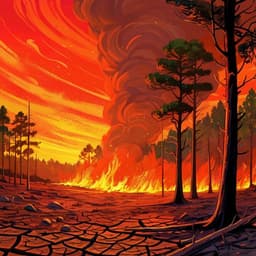
Earth Sciences
Human-driven greenhouse gas and aerosol emissions cause distinct regional impacts on extreme fire weather
D. Touma, S. Stevenson, et al.
This groundbreaking research by Danielle Touma, Samantha Stevenson, Flavio Lehner, and Sloan Coats reveals how past and future human activities shape wildfire risk. Discover how greenhouse gas-induced extreme fire weather may soar in the 21st century, especially in the Amazon, as aerosol-driven cooling wanes.
~3 min • Beginner • English
Introduction
The study investigates how distinct anthropogenic forcings—greenhouse gases (GHGs), industrial and biomass burning aerosols, and land-use/land-cover change (LULC)—have historically modified and will continue to modify regional fire-weather conditions that promote wildfire ignition and spread. Prior work has shown a human fingerprint on increased extreme fire weather across multiple regions (e.g., western US, Canada, Australia, Europe), with projections of continued increases under future warming. Yet, the competing and interacting roles of GHG warming versus aerosol cooling and LULC-induced climate effects on regional precipitation, humidity, and wind—and their net impact on wildfire risk—remain unclear. The purpose is to isolate and quantify each forcing’s contribution to extreme fire-weather risk historically and under future scenarios, to inform mitigation and adaptation planning.
Literature Review
The paper contextualizes recent increases in wildfire severity and area across many regions, attributing heightened extreme fire weather to anthropogenic warming that elevates temperatures and reduces precipitation. It cites attribution studies linking observed fire-weather extremes in western North America, Australia, southern Europe, and Siberia to human influence. Projections indicate widespread increases in extreme fire weather, even under low warming levels (e.g., doubling of risk in Sweden at +2 °C). Prior research has documented distinct climate impacts of GHGs, aerosols, and LULC on precipitation, relative humidity, and wind, but their combined effects on fire weather have been ambiguous. The study builds on large-ensemble approaches and previous single-forcing experiments that disentangle anthropogenic drivers of extreme heat and precipitation, extending this framework to fire weather.
Methodology
- Models and experiments: Used CESM1 Large Ensemble (CESM-LE; 35 members) fully forced historical + RCP8.5 (ALL) simulations, and CESM1 Single-Forcing Large Ensembles (CESM-LE-SF) that hold one forcing fixed at 1920 values: greenhouse gases (XGHG; 20 members), industrial aerosols (XAER; 20), biomass burning aerosols (XBMB; 15), and land-use/land-cover (XLULC; 5). XAER and XGHG extend to 2080; XBMB and XLULC end in 2029. Anthropogenic aerosol trajectories follow literature (industrial aerosols decrease to ~preindustrial by 2100; biomass burning emissions remain above preindustrial under RCP8.5).
- Fire Weather Index (FWI): Computed daily Canadian FWI from model daily maximum temperature (TREFHTMX), precipitation (PRECT), relative humidity (derived from PSL, QBOT, TREFHT via MetPy), and surface wind speed (WSPDSRFAV). FWI components (fuel moisture codes, initial spread, buildup) combined into unitless FWI.
- Extreme fire weather definition: For each grid and 30-year moving window (1920–2080), defined extreme events as daily FWI exceeding the 95th percentile (p95_t) of the ALL ensemble FWI distribution for that window.
- Risk ratio (RR): For each 30-year window, computed PALL_i = P(FWI_ALL_i ≥ p95_t) for each ALL member i, and PX_j = P(FWI_X_j ≥ p95_t) for each X ensemble member j. Used ensemble-mean PX over X members, then RR_i = PALL_i / PX. Mapped RR for specified periods (1920–1949, 1950–1979, 1980–2005, 2006–2029, 2030–2054, 2055–2080). Regions of interest defined in Supplementary Table 2. Significance indicated where ≥2/3 of ensemble members agree on RR > 1 or < 1.
- Mechanism isolation: Computed the forced effect of each forcing X on each meteorological variable V ∈ {T, PR, RH, WS} as V_effect_i = V_ALL_i − mean(V_X) (time-varying). Constructed detrended ALL member series by removing V_effect_i (absolute for T; fractional and non-negative for PR, RH, WS). Recalculated FWI and RR comparing original ALL vs detrended-ALL to quantify each variable’s contribution to RR under each forcing.
- Time of emergence (TOE): For ALL, XGHG, and XAER, defined TOE as the year when the 10-year moving average of annual frequency of extreme fire weather exceeds and stays above mean + 1 SD of the 1980–2005 ALL baseline. Considered robust if ≥1/3 of ensemble members showed permanent emergence before 2070. Computed median TOEs and differences between ALL and X ensembles to attribute acceleration/delay to GHGs or aerosols.
- Data and validation: Compared CESM-LE FWI 95th percentile spatial patterns against ERA-Interim reanalysis and CMIP5 models; discrepancies small and patterns comparable.
Key Findings
- Historical compensation: Throughout the 20th century, aerosol-forced cooling substantially compensated GHG-driven warming effects on extreme fire weather. Industrial aerosols reduced risk by ~30% in the Amazon and Mediterranean, but increased risk by ≥10% in Southeast Asia and western North America. Biomass burning aerosols increased risk by ≥30% in the Amazon and western North America. LULC amplified risk in the Amazon and western Australia.
- Present-day impacts: Between 1980–2005, GHGs amplified the risk of extreme fire weather by at least 20% in western/eastern North America, the Mediterranean, Southeast Asia, and the Amazon; risk had already doubled in northeastern Amazon by 2005.
- Future projections (RCP8.5): By 2055–2080, GHGs increase risk by ≥50% in western North America, equatorial Africa, Southeast Asia, and Australia, and at least double risk in the Mediterranean, southern Africa, eastern North America, and the Amazon. Parts of the Amazon experience ~7-fold increases in 2070–2080.
- Aerosol trajectory effects: As industrial aerosols decline in the 21st century, their compensating effect largely disappears. Some regions (Northeastern Europe, southern Amazon edge, western North America, parts of Australia) show slight aerosol-driven risk increases by century’s end; other regions (Horn of Africa, Central America, northeastern Amazon) retain some aerosol-driven risk reductions. Biomass burning emissions are not projected to return to preindustrial levels, so they continue to elevate risk above GHG-only effects in the Amazon and western North America.
- Mechanisms: GHG-driven increases in daily maximum temperature dominate RR increases globally (≥20% globally; >80% in the Amazon, eastern North America, and Southeast Asia throughout the 21st century). In parts of the Amazon, GHG-induced decreases in relative humidity and increases in wind speed individually more than double risk. By 2080, aerosol effects on maximum temperature dissipate over most land areas; however, aerosol-forced suppression of precipitation over Southeast Asia increases risk by ≥30%.
- Time of emergence (TOE): Forced changes in extreme fire weather emerge before 2080 over 74% of global land area; emergence occurs as early as 2030 in parts of the Amazon, eastern North America, the Mediterranean, and southern Africa. Permanent emergence generally requires inclusion of GHG forcing; aerosols delay TOE by ~15 years in parts of the Amazon, Mediterranean, and equatorial Africa. In parts of the western US, opposing influences (warming vs wetter atmospheric conditions) prevent permanent emergence by 2080.
Discussion
The findings demonstrate that anthropogenic GHGs are the primary driver of increasing extreme fire-weather risk, with pronounced regional amplification where additional meteorological changes (lower relative humidity, higher winds) compound warming, notably in the Amazon. Historically, industrial aerosols moderated GHG impacts by cooling, reducing risk and delaying emergence; their projected decline removes this buffer, leading to sharp increases in risk. Regionally heterogeneous aerosol effects, particularly continued emissions in Southeast Asia that weaken the monsoon and reduce precipitation, can paradoxically increase fire-weather risk despite local cooling. Biomass burning aerosols can increase risk in some regions (e.g., Amazon, western North America) through effects on clouds and precipitation. The analysis addresses the research question by quantifying each forcing’s contribution to extreme fire weather and elucidating mechanisms via temperature, humidity, precipitation, and wind pathways. The results are relevant for climate risk assessment and wildfire management, indicating that without GHG mitigation, extreme fire weather will become more frequent and persistent across most burnable land, with implications for preparedness, resource allocation, and international cooperation.
Conclusion
This study isolates and quantifies the distinct and interacting influences of GHGs, industrial and biomass burning aerosols, and LULC on global and regional extreme fire-weather risk using CESM large single-forcing ensembles and the Canadian FWI. Key contributions include: (1) evidence that aerosol cooling historically offset GHG-driven increases in fire-weather risk but will largely vanish as aerosols decline; (2) identification that rising temperatures are the dominant global mechanism, with additional regional amplification from reduced relative humidity and increased winds, particularly in the Amazon; (3) projections that, under RCP8.5, extreme fire weather emerges beyond historical variability across most land by 2080, with some regions experiencing multi-fold increases. Future work should incorporate multiple climate models and single-forcing ensembles to assess structural uncertainty, improve land model processes (e.g., irrigation), and explicitly represent ignition, fuel dynamics, and fire-vegetation feedbacks. Findings underscore the need for GHG mitigation and adaptation strategies, including strengthened international coordination for wildfire response as extreme fire weather becomes more widespread.
Limitations
- Model dependence: Results rely on a single climate model (CESM1), which carries structural uncertainties in mean state and variability.
- Forcing ensemble constraints: The all-but-LULC experiment has a small ensemble (n=5) and shorter duration (to 2029 for XBMB and XLULC), limiting robustness for those forcings.
- Process representation: The land model does not include irrigation, which could affect local humidity and temperature relevant to fire weather. Global climate models generally have limited, parameterized representations of ignition, fire spread, and fire-vegetation interactions.
- Indirect effects: While temperature, humidity, precipitation, and wind influences are isolated, indirect interactions among variables (e.g., temperature effects on relative humidity and winds) are not explicitly accounted for.
Related Publications
Explore these studies to deepen your understanding of the subject.







